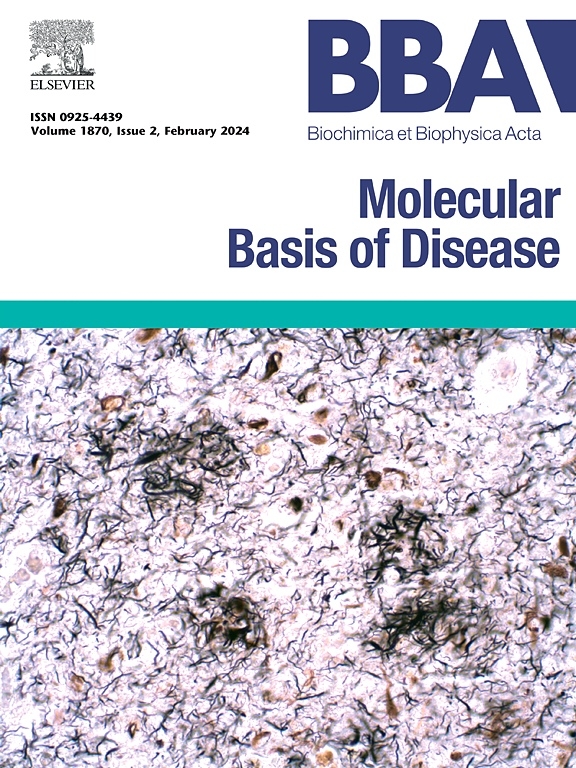多柔比星诱导的层粘连蛋白 A/C磷酸化可增强 DNMT1,并通过抑制大鼠心脏中的 GATA-4 和 Bcl-xL 激活心肌细胞死亡。
IF 4.2
2区 生物学
Q2 BIOCHEMISTRY & MOLECULAR BIOLOGY
Biochimica et biophysica acta. Molecular basis of disease
Pub Date : 2025-01-25
DOI:10.1016/j.bbadis.2025.167692
引用次数: 0
摘要
本文章由计算机程序翻译,如有差异,请以英文原文为准。

Doxorubicin-induced phosphorylation of lamin A/C enhances DNMT1 and activates cardiomyocyte death via suppressing GATA-4 and Bcl-xL in rat heart
Cardiotoxic effect of Doxorubicin (Dox) limits its clinical application. Previously, we reported that Dox induces phosphorylation of lamin A/C (pS22 lamin A/C), increased nuclear size, damage to the nuclear membrane, and cell death. However, the activation of signalling pathway during this event remains elusive, and it is unclear whether increased phospho-lamin A/C activates the cell death pathway in heart. Here, we demonstrated that Dox-induced lamin A/C phosphorylation causes apoptotic cell death. Increased levels of reactive oxygen species (ROS), DNA methylation and apoptosis markers (Bax, Bid, caspase 3 and caspase 9) were observed in Dox-exposed H9c2 cells. Nuclear membrane damage due to increased pS22 lamin A/C causes increased DNMT1 and DNA methylation followed by reduced expression of GATA-4 and Bcl-xL in Dox-treated H9c2 cells and rat hearts. Further, increased mRNA expression of DNMT1 and reduced expression of GATA-4 and Bcl-xL was observed in H9c2 cells after knocking down of lamin A/C expression. Previously, we reported that N-acetylcysteine improves lamin A/C levels and maintain nuclear membrane integrity. Similarly, in this study Astaxanthin (Ast), a membrane-specific antioxidant, reduces the expression of DNMT1 and phospho-lamin A/C levels; increases mRNA expression of GATA-4 and Bcl-xL; reduces ROS levels and DNA leakage in Dox-treated H9c2 cells and rat hearts. Ast also improves the cardiac structure and function in Dox-treated rats. In conclusion, Dox exposure in cardiomyoblasts and hearts causes cell death by increasing the pS22 lamin A/C, DNA methylation and reducing the expression GATA-4 and Bcl-xL. This study provides a novel pathway for Dox-induced cardiotoxicity and a possible therapeutic approach to reduce it.
求助全文
通过发布文献求助,成功后即可免费获取论文全文。
去求助
来源期刊
CiteScore
12.30
自引率
0.00%
发文量
218
审稿时长
32 days
期刊介绍:
BBA Molecular Basis of Disease addresses the biochemistry and molecular genetics of disease processes and models of human disease. This journal covers aspects of aging, cancer, metabolic-, neurological-, and immunological-based disease. Manuscripts focused on using animal models to elucidate biochemical and mechanistic insight in each of these conditions, are particularly encouraged. Manuscripts should emphasize the underlying mechanisms of disease pathways and provide novel contributions to the understanding and/or treatment of these disorders. Highly descriptive and method development submissions may be declined without full review. The submission of uninvited reviews to BBA - Molecular Basis of Disease is strongly discouraged, and any such uninvited review should be accompanied by a coverletter outlining the compelling reasons why the review should be considered.

 求助内容:
求助内容: 应助结果提醒方式:
应助结果提醒方式:


